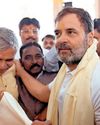
A nation's quest for national identity building, stability and social transformation depends on the development of science, technology and innovation (STI). The growth of China and India is dependent on technological transformation and technological leadership. As positive indicators of success, both countries are rising steadily in this field.
China is an upper middle-income country and India is a lower middle-income country. Being neighbours and starting their independent growth journeys simultaneously, they often prompt comparison between them. To forecast the future growth trajectory and global power trends involving these two countries, the science, technology and innovation (STI) indicators serve as a global framework for measurement, analysis, comparison, technological intelligence and strategic statistical data.
The chief components of these indicators include research and development endeavours and innovation systems.
India began its post-independence journey with the goals of modernisation and, having missed the industrial revolution, focused on planned public investments in higher education, science and technology, agriculture, energy and industry. As India faced a volatile strategic environment, S&T in defence and military became a necessity. The Indian space programme, nuclear programmes and Antarctic programme benefited from the support of the Soviet Union and sporadic contributions from the US and other western powers.
India has rolled out four strategic documents for STI since 1947-science policy resolution (1958), technology policy statement (1983), science and technology policy (2003) and science, technology and innovation policy (2013). The fifth one is soon to be launched as the national science, technology, and innovation policy and is under public consultation. These policies have underlined priorities, sectoral focus and strategies for STI development in India.
هذه القصة مأخوذة من طبعة July 21, 2024 من THE WEEK India.
ابدأ النسخة التجريبية المجانية من Magzter GOLD لمدة 7 أيام للوصول إلى آلاف القصص المتميزة المنسقة وأكثر من 9,000 مجلة وصحيفة.
بالفعل مشترك ? تسجيل الدخول
هذه القصة مأخوذة من طبعة July 21, 2024 من THE WEEK India.
ابدأ النسخة التجريبية المجانية من Magzter GOLD لمدة 7 أيام للوصول إلى آلاف القصص المتميزة المنسقة وأكثر من 9,000 مجلة وصحيفة.
بالفعل مشترك? تسجيل الدخول

Use multi-asset investing to overcome portfolio volatility
EQUITY MARKETS have been choppy during this year. After rallying for the better part of the first nine months of 2024, equities corrected sharply in October and November, before taking off once again on rally mode in December.

Twist of faith
Upamanyu Chatterjee is back with his wry sense of humour in his new novel, and most of it is directed at religion and spirituality

THE GLORY OF SARI
Saris of Memory weaves together history and textiles, highlighting key moments from the author's collection

We win together
We invented chess, which was pretty cool of us. The original game 'chaturanga'that is four divisions (infantry, cavalry, elephantry and chariotry)-was a war strategy game. When the game travelled to the Middle East, they mangled the Sanskrit and it ended up being called 'shatranj' instead.

BEATS THAT HEAL
Music ignites the light within us, says Grammy-winner Chandrika Tandon

Older, smarter, sexier
Those who worship him regardless of where he works have continued to do so. Such is the power of Alessandro Michele, that after being the face of some mega brands for 10 years (namely Gucci and now Valentino), he remains bigger than the labels themselves. His debut collection for Valentino was presented at the recent Paris Haute Couture Week, and it has been adored by his adorers.

The road to peace
Future political dialogues should explore means of ensuring a more robust autonomy to tribal communities

Diary of a Sherpa
Amitabh Kant's new book is a comprehensive account of the G20 Summit held in Delhi in 2023

The annoying orange
Everything is great. All is sunshine. I am an eternal optimist.\" It's the fad of our TikTok times everything is not great, the sun sets daily, nothing is eternal. If anything, everything is ephemeral, night brings darkness, and optimism often crumbles under the weight of history. British philosopher Roger Scruton warned: \"Hope untempered by the evidence of history is a dangerous asset, one that threatens not only those who embrace it, but all those within range of their illusions.\"

NO SEAT, YET UPBEAT
The Congress is buoyed by its increased vote share in Delhi, and feels it can push the AAP into further decline